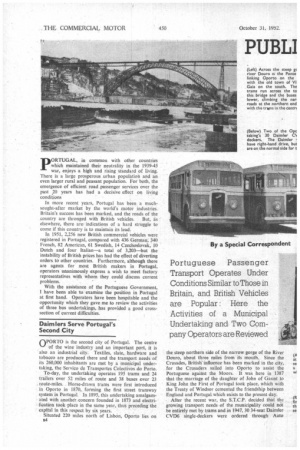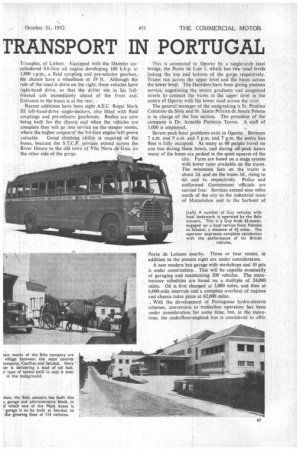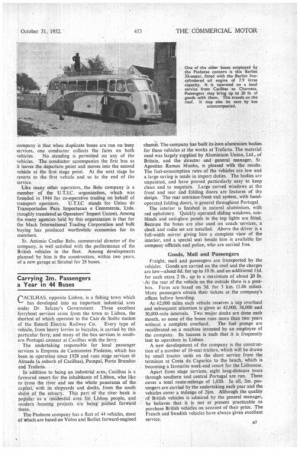PUBLI TRANSPORT IN PORTUGAL
Page 38

Page 39

Page 40

Page 41

If you've noticed an error in this article please click here to report it so we can fix it.
pORTLIGAL, in common with other countries which maintained their neutrality in the 1939-45 war, enjoys a high and rising standard of living. There is a large prosperous urban population and an even larger rural and "peasant population. For both, the emergence of efficient road passenger services over the past 20 years has had a decisive effect on living conditions
In more recent years, Portugal has been a muchsought-after market by the world's motor industries. Britain's success has been marked, and the roads of the country are thronged with British vehicles. But, as elsewhere, there are indications of a hard struggle to come if this country is to maintain its lead.
In 1951, 2,256 new British commercial vehicles were registered in Portugal, compared with 436 German; 340 French, 82 American, 61 Swedish, 14 Czechoslovak, 10 Dutch and four Italian—a total of 3,203—but the instability of British prices has had the effect of diverting orders to other countries. Furthermore, although there are agents for most British makers in Portugal, operators unanimously express a wish to meet factory representatives with whom they could discuss current problems.
With the assistance of the Portuguese Government, I have been able to examine the position in Portugal at first hand. Operators have been hospitable and the opportunity which they gave me to review the activities of three bus undertakings, has provided a good crosssection of current difficulties.
OPORTO is the second city of Portugal. The centre of the wine industry and an important port, it is also an industrial city. Textiles, slate, hardware and tobacco are produced there and the transport needs of its 260,000 inhabitants are met by a municipal undertaking, the Servico de Transportes Colectivos do Porto. To-day, the undertaking operates 195 trams and 24 trailers over 52 miles of route and 38 buses over 23 , route-miles. . Horse-drawn trams were first introduced in Oporto in 1870, forming the first street tramway system in Portugal. In 1895, this undertaking amalgamated with another concern founded in 1873 and electrification took place in the same year, thus preceding the capital in this respect by six years.
Situated 220 miles north of Lisbon, Oporto lies on att
the steep northern side of the narrow gorge of the River Do-uro, about three miles from its mouth.. Since the Crusades, British' influence has been marked in the city, for the Crusaders sailed into Oporto to assist the Portuguese against the Moors. It was here in 1387 that the, marriage of the daughter of John of Gaunt to King John the First of Portugal took place, which with the Treaty of Windsor cemented the friendship between England and Portugal. which exists to the present day.
After the recent war, the S.T.C.P. decided that the growing transport needs of the municipality could not be entirely met by trams and in 1947, 30 34-seat Daimler CVD6 single-deckers were ordered through Auto Triunpho, of Lisbori. Equipped with the Daimler six= cylindered 8.6-litre oil engine developing 100 b.h.p. at 1,800 r.p.m., a fluid coupling and pre-selector gearbox, the chassis have a wheelbase of 19 ft. Although the rule of the road is drive on the right, these vehicles have right-hand drive, so that the driver sits in his fullfronted cab immediately ahead of the front exit. Entrance to the buses is at the rear. .
Recent additions have been eight A.E.0 Regal Mark III left-band-drive single-deckers, also fitted with fluid couplings and pre-selector gearboxes. Bodies are now being built for the Chassis and when the vehicles are complete they will go into service on the steeper routes, where the higher output of the 9.6-litre engine will prove
valuable. Good climbing ability is required of the buses, because the S.T.C.P. services extend across the River Douro to the old town of Vila Nova de Gaia on the other side of the gorge. This is connected to Oporto by a single-arch steel bridge, the Ponte de Luis 1, which has two road levels linking the top and bottom of the gorge respectively. Trams run across the upper level and the buses across the lower level. The Daimlers have been giving yeoman service, negotiating the severe gradients and congested Streets to connect the trams at the upper level in the Centre of Oporto with The lower road across the river.
The general manager of the undvaking is Sr. Paulin° Celestino da Silva and Sr. Jaime Pereira de Souza Peisoa is in charge of the bus section. The president of the company is Dr. Arnaldo Pinheiro Torres. A staff of 3,000 is employed.
Severe peak-hour problems exist in Oporto. Between 7 a.m. and 9 a.m. and 5 p.m. and 7 p.m. the entire bus fleet is fully occupied. As many as 60 people travel on one bus during these hours, and during off-peak hours many of the buses are parked in the quiet squares of the city. Fares are based on a stage system with lower rates available on the trams. The minimum fare on the trams is about 2d. and on the buses 3d., rising to 6d. and Is. respectively. Police and uniformed Government officials are carried free. Services extend nine miles north of the city to the industrial town of Matozinhos and to the harbour of Porto de Leixoes nearby. Three or four routes, in addition to the present eight are under consideration.
A new modern bus garage with workshops and 10 pits is under construction. This will be capable eventually of garaging and maintaining 200 vehicles. The maintenance schedules are based on a multiple of 24,000 miles. Oil is first changed at 3,000 miles, and then at 6,000-mile intervals and a complete overhaul of engines and chassis takes place at 62,000 miles.
With the development of Portuguese hydro-electric schemes, conversion to trolleybus operation has been under consideration for some time, but, in the meantime, the underfloor-engined bus is considered to offer matty advantages. A gearbox with a super-low ratio is essential in Oporto and it is claimed that the presence of this ratio enables a saving of 8 per cent. to be made on average fuel consumption.
Many amenities are offered to the staff. There is a fine canteen, with waitress service, where meals can be obtained at 1014. or Is. 414. (including table wine). A co-operative store is maintained at which groceries and other commodities can be purchased at reduced prices by employees and their families. Employees working early or late shifts and who live some distance from the depots may spend the night in the excellent sleeping quarters which are provided. It is not surprising that the visitor to Oporto is impressed by the outstanding kindness and courtesy of the operating staff.
Some indication of the influence of the excellent social services provided for the staff and a the efficiency of the administration and employees is provided in the annual report for the year ended December 31, 1951. During the year the trams and buses together carried 89,616,086 passengers, and the mileage covered was 7,460,867. The buses carried 3,690,888 passengers, an increase of 16 per cent. over the number for 1950. 3,177,676.
Buses Preferred There was clear evidence during the year that passengers 'preferred the buses more and more, for during 1951 the number of passengers carried by the trams fell from 87,894,756 to 85,925,198. The tram fleet, on the other hand, was reduced by only one vehicle, from 196 to 195, whilst the number of trailers remained at 24.
In 1950 the bus fleet totalled 29 and covered 544,772 miles. In 1951 a fleet of 30 vehicles covered 720,945 miles. The trams cover a route-mileage of 52.25 and the buses 23.5. Total receipts in 1951 reached £9,764,413 and expenditure was £8,536,231. After meeting various charges, a surplus of £209,302 was recorded.
PORTUGAL'S third city is Setubal. Situated 25 miles south of Lisbon, the town lies on the mouth of the River Sado and apart from the fishing and sardine canning industries carried on there, is also the centre of
the Muscatel wine area. One of the larger private operators in Portugal, Organizacao da Transportadora Setubalense de Joao Candido Belo et Ca., Ltda., is based there.
This company was founded in 1928 and to-day operates a fleet of 124 single-deck vehicles on 66 stage and express-carriage services in central and southern Portugal. The total route mileage is 1,600. More than 5,000 passengers are carried daily over 7,200 miles. An important function is performed by this concern in company with others of like nature, because, although the railway system is good, not every town is provided with rail connections. Indeed, some villages and small towns are completely isolated. Company-operated bus services serve places of this type.
Four of the services run by the Belo company are operated under a concession from the Portuguese railways and link other country districts with the rail terminus at Barreiro. From this point, fast steamers convey passengers across the River Tagus to Lisbon in 45 minutes. The road journey around the river is long and difficult.
Guy Otter single-deckers with Gardner 4LK oil engines, Guy Arabs, Leyland Tigers and Berliet, Volvo and Mack vehicles are found in the fleet. The Berliet buses have the 7.9-litre five-cylindered engine which produces 120 b.h.p. at 2,00Ci r.p.m., whilst the Volvo models are of the 13513 type *0 six-cylindered 6.13litre engine producing 95 b.h.p. at 2,000 r.p.m.
Locally Built Bodies Bodywork for these vehicles is built locally and some fine-looking vehicles are maintained. Seating capacity varies from 31 to 44. The backbone service of the Belo concern is from Setubal to Cacilhas. Cacilhas is a fishing town immediately opposite Lisbon on the River Tagus, and is the main northern terminal of bus companies operating south of the capital. Midway between the two towns, in the village of Vila Fresca de Azeitao, is the headquarters of the Belo company. New offices, garage, workshops and a large bus station have been built there. At the front of the building is the bus station, into which buses draw off the main road. Above it are the offices and spares department.
Extending over a large acreage at the rear of the offices is the works. This is equipped with new machine tools, including Pasquino lathes made in Milan, Wandess special-purpose tools and a Elartridge fuelpump test outfit. A complete tyre-vulcanizing depart
ment is also maintained. It is here that periodical inspection and major docks are carried out. Major overhauls are usually undertaken at 120,000-mile intervals. The chief engineer is Sr. Fernando Ricardo.
Other buildings associated with the station include the employees' canteen and cloakrooms, which are equipped with shower baths. Eventually over 400 people will be employed at the works.
To avoid the impact of the heavy import duty on bodies, of 2s. 6d. per kg , the company. builds some of its own bodies. The duty on chassis is less than half that on bodies, and works out at about ls. 2d. per kg.
The general level of fares is remarkably low and is based on 30 centavos a km., which is less than Id.
Reductions are available on return tickets and many passengers buy their tickets at booking offices at the various termini. An interesting operating detail of this company is that when duplicate buses are run on busy services, one conductor collects the fares on both vehicles. No standing is permitted on any of the vehicles. The conductor accompanies the first bus as it leaves the departure point and moves into the second vehicle at the first stage point. At the next stage he reverts to the first vehicle and so to the end of the service. .
Like many other operators, the Belo company is a member of the U.T.I.C. organization, which was founded in 1944 for co-operative trading on behalf of transport operators. U.T.I.0 stands for Uniao de Transportados Para Importacao e Commercia, Ltda. (roughly translated as Operators' Import Union). Among the many agencies held by this organization is that for the Mack International Trading Corporation and bulk buying has produced worthwhile economies for its members.
Sr. Antonio Coelho Belo, commercial director of the company, is well satisfied with the performance of the British vehicles in the fleet. Among developments planned by him is the construction, within two years, of a new garage at Setubal for 28 buses.
rACILHAS, opposite Lisbon, is a fishing town which has developed into an important industrial area under Dr. Salazar's Government. Three excellent ferryboat services cross from the town to Lisbon, the shortest of which operates to the Cais de Sodre station of the Estoril Electric Railway Co. Every type of vehicle, from heavy lorries to bicycles, is carried by this particular ferry, and many of the bus services in southern Portugal connect at Cacilhas with the ferry.
The undertaking responsible for local passenger services is Empresa de Camionetes Piedense, which has been in operation since 1928 and runs stage services to Almada (a suburb of Cacilhas), Ponapal, Porto Brandao and Trafaria.
In addition to being an industrial area; Cacilhas is a favoured resort for the inhabitants of LiSbon, who like to cross the river and see the whole panorama of the capital, with its shipyards and docks, from the south shore of the estuary. This part of the river bank is popular as a residential area for Lisbon people, and modern housing projects are being pushed forward there.
The Piedense company has a fleet of 44 vehicles, most of which are based on Volvo and Berliet forward-engined
chassis. The company has built its "own aluminium bodies for these vehicles at the works at Trafaria. The material used was largely supplied by Aluminium Union, Ltd., of Britain, and the director and general manager, Sr. Agostino Ramos Munha, is pleased with the results. The fuel-consumption rates of the vehicles are low and a large saving is made in import duties. The bodies are unpainted, and have proved particularly easy to keep clean and to maintain. Large curved windows at the front and rear and folding doors are features of the design. The rear entrance-front exit system, with hand operated folding doors, is general throughout Portugal.
The interior is finished in natural aluminium, with red upholstery. Quickly operated sliding windows, sunblinds and anti-glare panels in the top lights are fitted. Because the buses are also used on coach services, a clock and radio set are installed. Above the driver is a full-width mirror giving him a complete view of the interior, and a special seat beside him is available for company officials and police, who are carried free.
Goods, Mail and Passengers Freight, mail and passengers are transported by the vehicles. Goods are carried on the roof and the charges are low—about 6d. for up to 10 lb. and an additional Rd. for each extra 2 lb., up to a maximum of about 7,o lb. At the rear of the vehicle on the outside there is a postbox. Fares are based on 3d. for 3 km. (1.86 miles). Many passengers obtain their tickets at the company's offices before boarding.
At 62,000 miles each vehicle receives a top overhaul and subsequent attention is given at 42,000, 36,000 and 30,000-mile intervals. Two major docks are done each month, so none of the buses runs more than two years without a complete overhaul. The fuel pumps are recalibrated on a machine invented by an employee of the company. Its Success is such that it is frequently lent to operators in Lisbon.
A new development of the company is the construction of a number of 16-seat trailers, which will be drawn by small tractor units on the short service from the terminus at Costa da Caparica to the beach, which is becoming a favourite week-end resort for the Lisbonese.
Apart from stage services, eight long-distance tours through southern and central Portugal are run. These cover a total route-mileage of 1,020. In all, 2m. passengers are carried by the undertaking each year and the vehicles cover a mileage of 21m. Although the quality of British vehicles is admired by the general manager, he believes that it is not at present practicable to purchase British vehicles on account of their price. The French and Swedish vehicles have always given excellent service.












































































